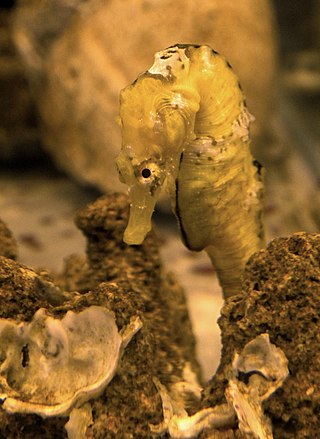
Fishery can mean either the enterprise of raising or harvesting fish and other aquatic life; or more commonly, the site where such enterprise takes place. Commercial fisheries include wild fisheries and fish farms, both in freshwater waterbodies and the oceans. About 500 million people worldwide are economically dependent on fisheries. 171 million tonnes of fish were produced in 2016, but overfishing is an increasing problem — causing declines in some populations.

A conventional idea of a sustainable fishery is that it is one that is harvested at a sustainable rate, where the fish population does not decline over time because of fishing practices. Sustainability in fisheries combines theoretical disciplines, such as the population dynamics of fisheries, with practical strategies, such as avoiding overfishing through techniques such as individual fishing quotas, curtailing destructive and illegal fishing practices by lobbying for appropriate law and policy, setting up protected areas, restoring collapsed fisheries, incorporating all externalities involved in harvesting marine ecosystems into fishery economics, educating stakeholders and the wider public, and developing independent certification programs.

Daniel Pauly is a French-born marine biologist, well known for his work in studying human impacts on global fisheries and in 2020 was the most cited fisheries scientist in the world. He is a professor and the project leader of the Sea Around Us Project at the Institute for the Oceans and Fisheries at the University of British Columbia. He also served as Director of the UBC Fisheries Centre from November 2003 to October 2008.

The leafy seadragon or Glauert's seadragon, is the only member of the genus Phycodurus and is a marine fish in the family Syngnathidae, which includes seadragons, pipefish, and seahorses.

The Syngnathidae is a family of fish which includes seahorses, pipefishes, and seadragons. The name is derived from Ancient Greek: σύν, meaning "together", and γνάθος, meaning "jaw". The fused jaw is one of the traits that the entire family have in common.

The common seadragon or weedy seadragon is a marine fish related to the seahorses. Adult common seadragons are a reddish colour, with yellow and purple markings; they have small leaf-like appendages that resemble kelp fronds providing camouflage and a number of short spines for protection. Males have narrower bodies and are darker than females. Seadragons have a long dorsal fin along the back and small pectoral fins on either side of the neck, which provide balance. Common seadragons can reach 45 cm (18 in) in length.

Marine conservation, also known as ocean conservation, is the protection and preservation of ecosystems in oceans and seas through planned management in order to prevent the over-exploitation of these marine resources. Marine conservation is informed by the study of marine plants and animal resources and ecosystem functions and is driven by response to the manifested negative effects seen in the environment such as species loss, habitat degradation and changes in ecosystem functions and focuses on limiting human-caused damage to marine ecosystems, restoring damaged marine ecosystems, and preserving vulnerable species and ecosystems of the marine life. Marine conservation is a relatively new discipline which has developed as a response to biological issues such as extinction and marine habitats change.

The West African seahorse is a species of fish in the family Syngnathidae. It is found in the eastern central Atlantic Ocean off Angola, Benin, Ivory Coast, Gambia, Ghana, Guinea, Liberia, Nigeria, São Tomé and Príncipe, Senegal, and Sierra Leone, as well as the Canary Islands. Although there have been no records from Algeria since Guichenot said that the type was collected at Béjaïa in the 1850s, but the location given may be an error.

Barbour's seahorse is a species of fish of the family Syngnathidae.
Sustainable seafood is seafood that is caught or farmed in ways that consider the long-term vitality of harvested species and the well-being of the oceans, as well as the livelihoods of fisheries-dependent communities. It was first promoted through the sustainable seafood movement which began in the 1990s. This operation highlights overfishing and environmentally destructive fishing methods. Through a number of initiatives, the movement has increased awareness and raised concerns over the way our seafood is obtained.

Heather Koldewey is the co-founder of Project Seahorse and head of marine and freshwater for the Zoological Society of London-London Zoo Aquarium. She additionally serves as an honorary professor for University of Exeter and a National Geographic explorer. Her research interests focus on marine and freshwater conservation, seahorse biology and genetics, and the impact of the aquarium trade on wild populations of fish and aquatic invertebrates.

Amanda Vincent is a Canadian marine biologist and conservationist, one of the world's leading experts on seahorses and their relatives. She currently holds the chair of the IUCN SSC Seahorse, Pipefish and Seadragon Specialist Group and is the marine representative on the IUCN's International Red List Committee as well as being the chair of its Marine Conservation Committee. She previously held the Canada Research Chair in Marine Conservation at the UBC Institute for the Oceans and Fisheries at the University of British Columbia (UBC), Canada from 2002 to 2012. Vincent co-founded and directs Project Seahorse, an interdisciplinary and international organization committed to conservation and sustainable use of the world's coastal marine ecosystems. In 2020 she became the first marine conservationist to win the world's leading prize for animal conservation, the Indianapolis Prize.
The following outline is provided as an overview of and topical guide to fisheries:

The Patagonian seahorse is a species of marine fish of the family Syngnathidae. It inhabits coastal waters from northeastern Brazil to Chubut, Argentina. It generally is found at shallow depths attached to natural or artificial substrates. This species is ovoviviparous, with males brooding eggs in a brood pouch before giving birth to live young.

The Great Southern Reef is a system of interconnected reefs that spans the southern coast of continental Australia and Tasmania and extends as far north as Brisbane to the east and Kalbarri to the west. It covers 71,000 km2 (27,000 sq mi) of ocean and straddles five states, running along the coast for 8,000 km (5,000 mi).
The UBC Institute for the Oceans and Fisheries (IOF) is a research unit at the University of British Columbia (UBC) that was formed in 2015 by incorporating members from the former UBC Fisheries Centre, as well as a subset of researchers that are conducting marine related research at UBC. The IOF developed its own graduate program, which welcomed its first cohort of graduate students in September 2019. In addition to students of its OCF program, members are also drawn from other graduate programs at UBC, primarily from the Institute for Resources, Environment and Sustainability, the Departments of Earth, Ocean and Atmospheric Sciences, Zoology, Geography, and Botany, and the School of Public Policy and Global Affairs. The UBC Institute for the Oceans and Fisheries brings together a community of Canadian and international experts in ocean and freshwater species, systems, economics, and issues to provide new insights into how global marine systems function, and the impacts of human activity on those systems. It is working towards a world in which the oceans are healthy and their resources are used sustainably and equitably. IOF is located at The University of British Columbia, and promotes multidisciplinary study of aquatic ecosystems and broad-based collaboration with researchers, educators, maritime communities, government, NGOs, and other partners.

Marine Conservation Cambodia (MCC) is a non-profit, marine conservation organisation based in Koh Ach Seh, Kep archipelago.

Histiogamphelus cristatus, known as Macleay's crested pipefish or rhino pipefish, is a species of marine fish belonging to the family Sygnathidae. This species can be found in a variety of marine habitats such as seagrass beds, sandy ocean bottoms, and estuaries, surrounding south and southwestern Australia. Their main source of food are small crustaceans found in the water column or in sediments. Males of the species brood eggs and give birth to live offspring.

Urocampus nanus, commonly known as the barbed pipefish, is a species of marine fish belonging to the family Syngnathidae. This family consists of 56 different genera and 320 species.

Vanacampus phillipi, also known as the Port Phillip pipefish is a species of marine fish belonging to the family Syngnathidae. They can be found inhabiting seaweed and seagrass beds along the southern coast of Australia from Perth to Jervis Bay, New South Wales including the coast of Tasmania. Their diet consists of small crustaceans such as copepods, amphipods, and mysid shrimps. Reproduction occurs through ovoviviparity in which the males brood eggs before giving live birth to 50 or less offspring.


















